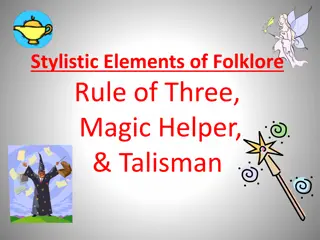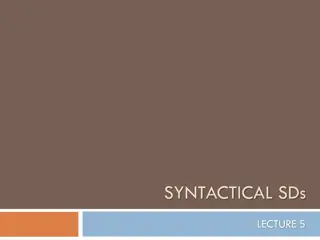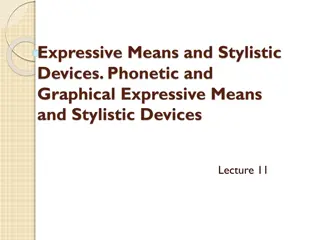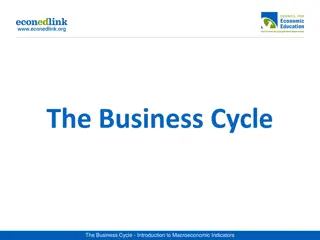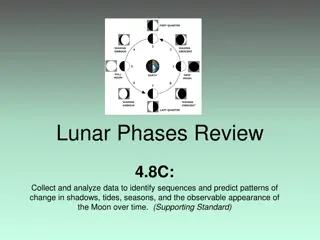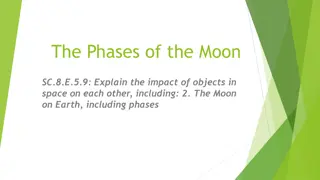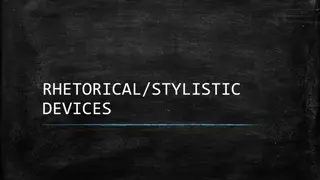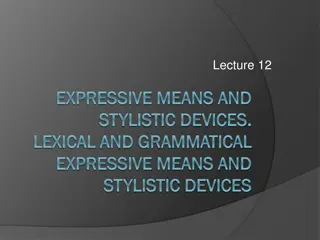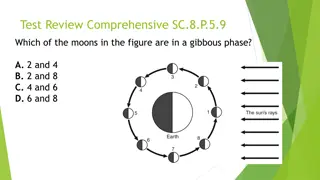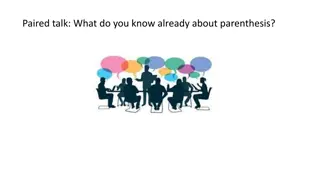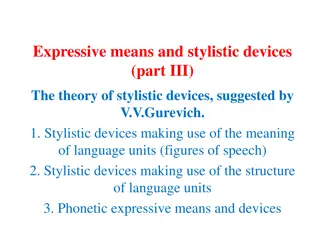Guide to Stylistic Analysis: Research and Writing Phases
Explore the essential phases of stylistic analysis - research and writing-up. Begin with thorough preparation and analysis in the research phase, followed by careful selection of key elements. Then, transition to the writing-up phase by crafting a detailed account of your insights and structuring your analysis effectively for your reader.
Download Presentation

Please find below an Image/Link to download the presentation.
The content on the website is provided AS IS for your information and personal use only. It may not be sold, licensed, or shared on other websites without obtaining consent from the author. Download presentation by click this link. If you encounter any issues during the download, it is possible that the publisher has removed the file from their server.
E N D
Presentation Transcript
m.short@lancaster.ac.uk http://www.lancs.ac.uk/fass/projects/stylistics/ Mick Short s Take on Stylistics, Going About a Stylistic Analysis and Writing it Up
Distinguish the phases 1. The research phase 2. The writing up phase
The research phase: A. Preparation First, read and re-reread for understanding Then look up context, and references, words (OED!), allusions etc and make notes when re- reading if these factors change, enhance your understanding etc Note down every factor you must analyse. Briefly write down what you think of the text in terms of interpretation and effects, so that you don t slide interpretatively later (you can then re- examine your initial thoughts after analysis too) If you must read critics, find one to disagree with.
The research phase: B. Analysis Be analytically precise strive to be accurate and don t be afraid to do the detail Be dispassionate and open, honest and truthful with yourself in the research phase and with your reader in the writing-up phase Be systematic: Analyse all the aspects and all the levels Analyse all the text you are considering
The research phase: C. Selection After analysis, check back on your original interpretative statements etc and see if you have changed your mind or can now say with more precision what you originally said more generally. Write down any changes. Select from all that analysis which kinds of analysis MUST be included in the essay, which you need to get in in less detail and which can be forgotten about, by and large. Write your decisions down, so that you can refer to them Work out what the STORY of your essay is going to be.
The writing-up phase: 1 Begin by writing your general account of your understanding, effects that the text generates etc (including reference to relevant contextual etc matters). Don t be afraid to say that you changed your mind, understood more accurately, or whatever after analysis Don t forget you have a reader. Help the reader to know where you are going, and why.
The writing-up phase: 2 Now concentrate on how to present your argument for your views to your reader Work out the best structure for writing up your analysis relevant to your interpretation What sections? What order for the sections? What to present in each section and in what order? Don t forget that even the best structuring will have some disadvantages Repair the disadvantages in your writing of the sentences (e.g. cross-section referencing
The writing-up phase: 3 Don t waste words you can t afford to Be clear: write as simply and straightforwardly as you can You don t have to tell us you are doing a stylistic analysis etc. We already know that You don t have to include what other people have said unless it is relevant to your argument. Just analyse (but do put a bibliography at the end) You don t have to write a conclusion summarising what you have already said (but it does help to conclude with any new things your analysis has brought to light etc)
A Theoretical Interlude: Foregrounding: A Psychological Phenomenon Created by: (Linguistic) Deviation A --------------- ago Mick s bow tie and . . . (Linguistic) Parallelism I kissed thee ere I killed thee (Othello) Main and sub-plot in King Lear
The Secret We all dance round in a ring and suppose, But the Secret sits in the middle and knows. (Robert Frost)
Extract from a story called Mir, Mir, on the wall , from Colum McCann s, Let the Great World Spin (published in 2009:. 78-9). Claire Soderberg, a wealthy American woman whose son has been killed in the war in Vietnam, is part of a small, newly-formed group of bereaved mothers of war victims who support one another. The other mothers are much less well off than Claire. They meet at each other s houses and they are about to meet at Claire s penthouse flat for the first time. Claire is worrying about the other women feeling overawed. The sentences are numbered for your convenience.
A quick shiver splits through her: the doorman. (1) Wonder, will he question them too much? (2) Who is it today? (3) Melvyn, is it? (4) The new one? (5) Wednesday. (6) Melvyn, yes. (7) If he mistakes them for the help? (8) If he shows them to the service elevator? (9) Must call down and tell him. (10) Earrings! (11) Yes. (12) Earrings. (13) Quick now. (14) In the bottom of the box, an old pair, simple silver studs, seldom worn. (15) The bar a little rusty, but no matter. (16) She wets each stem in her mouth. (17) Catches sight of herself in the mirror again. (18) The shell-patterned dress, the shoulder-length hair, the badger streak. (19) She was mistaken once for the mother of a young intellectual seen on television, talking of photography, the moment of capture, the defiant art. (20) She too had a badger streak. (21) Photographs keep the dead alive, the girl had said. (22) Not true. (23) So much more than photographs. (24) So much more. (25)
(28) She reaches for the tissues beyond the glass figurines on the dresser, dries her eyes. (29) Runs to the inner hallway, picks up the ancient handset. (30) Melvyn? (31) She buzzes again. (32) Maybe outside smoking. (33) Melvyn?! (34) Yes, Mrs. Soderberg? (35) His voice calm, even. Welsh or Scottish she's never asked. (36) I have some friends dining with me this morning. (37) Yes, ma'am. (38) I mean, they're coming for breakfast. (39) Yes, Mrs. Soderberg. (40) Eyes a little glassy already. (26) Not good. (27) Buck up, Claire.
Dining? (42) Did I really say dining? (43) How could I say dining? (44) You'll make sure they're welcome? (45) Of course, ma'am. (46) Four of them. (47) Yes, Mrs. Soderberg. (48) Breathing into the handset. (49) That fuzz of red mustache above his lip. (50) Should have asked where he was from when he first started working. (51) Rude not to. (52) Anything else, ma'am? (53) Ruder to ask now. (54) Melvyn? (55) The correct elevator. (56) Of course, ma'am. (57) Thank you. (58) She runs her fingers along the dark wainscoting of the corridor. (41)
She shouldn't have said anything at all about a correct or incorrect elevator. (60) A bushe, Solomon would have said. (61) Melvyn'll be down there, paralyzed, and then he'll put them in the wrong one. (62) The elevator there to your right, ladies. (63) In you go. (64) She feels a flush of shame to her cheeks. (65) But she used the word dining, didn't she? (66) He'll hardly mistake that. (67) Dining for breakfast. (68) Oh, my. (69) The overexamined life, Claire, it's not worth living. (70) She leans her head against the cool of the wall. (59)

 undefined
undefined















